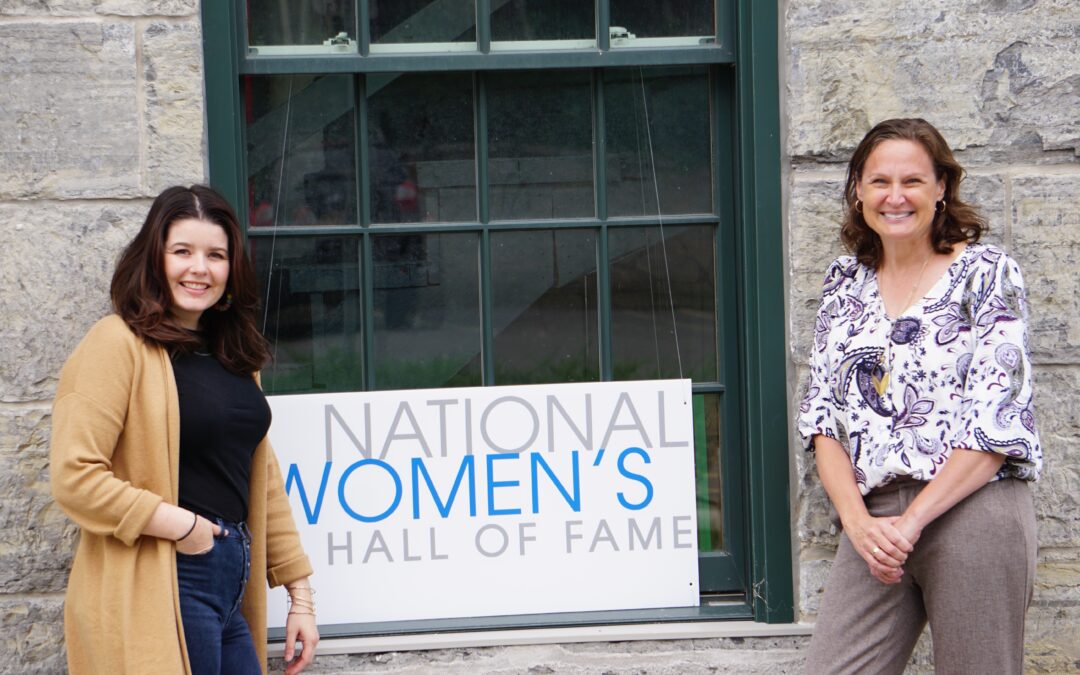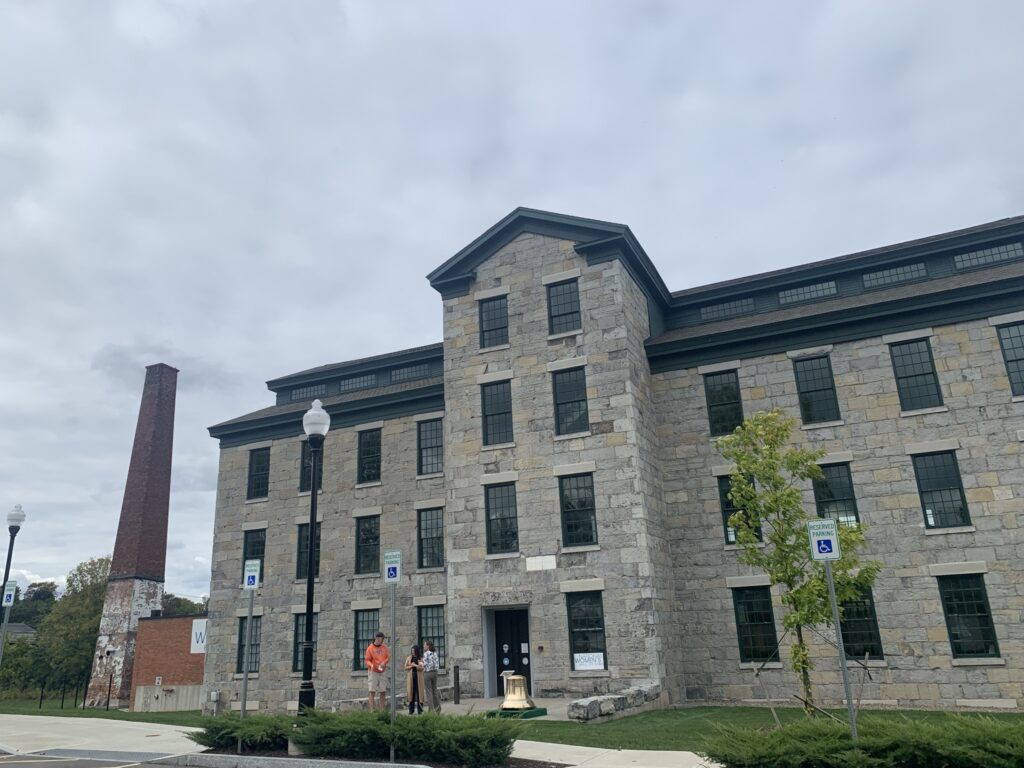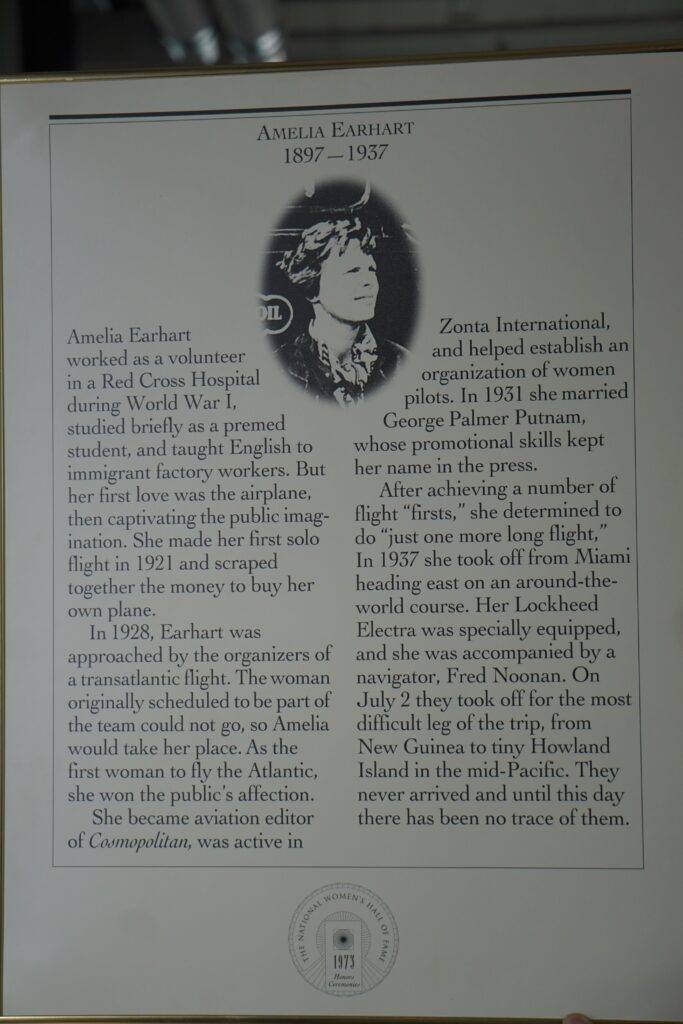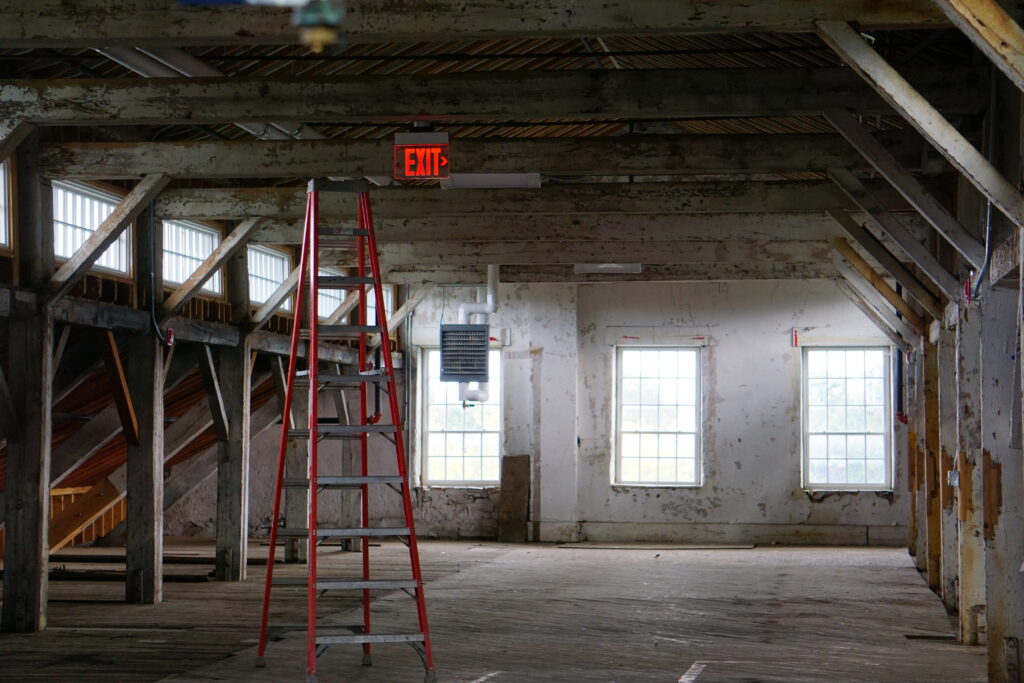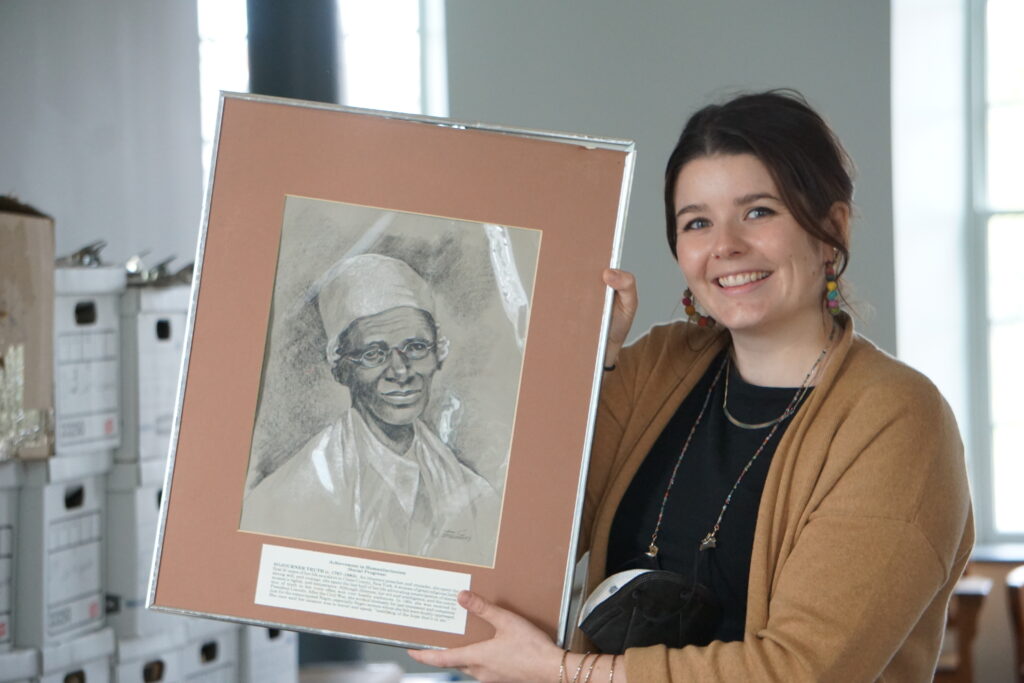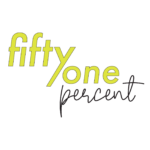
On this week’s 51%, we take a tour of the National Women’s Hall of Fame in Seneca Falls, New York. Executive Director Jennifer Gabriel previews the hall’s latest class, and shares her goals for the museum’s expansion.
Guests: Jennifer Gabriel, Executive Director of the National Women’s Hall of Fame; Natalie Rudd, Learning & Engagement Manager
51% is a national production of WAMC Northeast Public Radio. The show is hosted by Jesse King, its executive producer is Dr. Alan Chartock, and its theme is “Lolita” by the Albany-based artist Girl Blue.
Follow Along
You’re listening to 51%, a WAMC production dedicated to women’s issues and experiences. Thanks for tuning in, I’m Jesse King. This week, we’re taking a field trip to Seneca Falls, New York. Now, Seneca Falls is an important location for women’s history, being the site of the Seneca Falls Convention in 1848, where activists like Elizabeth Cady Stanton, Lucretia Mott, and Martha Wright signed the “Declaration of Sentiments” calling for equal rights for women.
There are a lot of places we could visit in Seneca Falls and talk about, but today we’re stopping at the National Women’s Hall of Fame. It’s been a part of the area for decades, but after years of renovations it now occupies the historic Seneca Knitting Mill on Canal Street, in plain view of the recreated Wesleyan Chapel, where the Seneca Falls Convention took place.
So after saddling up the company vehicle and making my way west to Seneca County, I found my way to the wool mill, a large stone structure nestled by the Seneca-Cayuga Canal. I’m immediately greeted by Executive Director Jennifer Gabriel and Learning & Engagement Manager Natalie Rudd, who are kind enough to hold open the door as I lug in my recording equipment. Gabriel was selected to be the museum’s new executive director after a six-month, national search in July. She says she’s spent the past two decades working in non-profit organizations in New York, Colorado, and California – particularly in fundraising – and that might come in handy for the National Women’s Hall of Fame, as it grows into its new space and navigates the coronavirus pandemic.
I got the change to sit down with Gabriel, and started by asking about the Hall’s history, and her vision for its future.
How has the museum gotten to where it is today? What are your goals as executive director?
So the National Women’s Hall of Fame is over 50 years old, we’re the first and oldest organization and museum dedicated to telling the stories of great American women. The whole organization began in the late ‘60s, when a woman named Shirley Hartley learned about the Hall of Great Americans, which was housed at New York University. And she was really troubled to learn that only a small portion of the people that were honored there were women. And being from Seneca Falls and working in Seneca Falls, she really felt strongly that this was the place that needed to house an organization dedicated specifically to celebrating women. And so she came back to Seneca Falls, gathered her friends and some associates and colleagues, and created what she called “The Founders Tea,” which was a homage to the tea that Elizabeth Cady Stanton first organized with Susan B. Anthony and Lucretia Mott, and all of the people that we associate with the women’s rights movement. So Shirley Hartley did a similar tea, and that was the impetus for the founding of the National Women’s Hall of Fame.
So a year later in 1969, we were incorporated as a nonprofit organization. And we’ve been right here in Seneca Falls ever since. Sometime in the late ‘70s, the organization moved from the basement of one of the local colleges to a small storefront on Fall Street in downtown Seneca Falls, and that’s where we lived and thrived for 41 years. Eventually, we got to the point where we had outgrown that space, and so, in 2007, the organization embarked on a major campaign to purchase and renovate the building that we’re in right now. So is this the Seneca Knitting Mill, which has been around since 1844, and was a producer of wool yarn and wool goods for its entire 155-year history. And one of the things I find really fascinating about this, is that the history of the building that we’re in now, the Seneca Knitting Mill, and the history of the National Women’s Hall of Fame, and the women’s rights movement, are really, deeply intertwined. Some of the owners of the of the Seneca Knitting Mill in 1848, when the first women’s rights convention was happening, were actually signers on the Declaration of Sentiments. The business itself was really committed to supporting women’s rights and equity issues from the very beginning.
We purchased the building in 2007, and began an extensive campaign to renovate the building. And actually, what you see today is a stone structure with a brick smokestack – it’s incredibly beautiful, right on the shores of the Seneca-Cayuga canal. And at the time that we purchased it, it had really fallen into disrepair. The Seneca Knitting Mill went out of business in 1999, so it had been largely neglected. It needed a new roof, new windows. And so the organization embarked on this initiative to make this our new home. We were able to move into this building in August of 2020. So it’s just been just over a year since we’ve been here.
To get back to your question about where the organization is going and what’s on the horizon. It’s really threefold. So the first is to complete the Seneca Knitting Mill project, and to have four floors of exhibits and event space and spaces that are designed to create interactive educational experiences for people of all ages, all genders, you know, from all across the country. The second is to ensure that our induction ceremony, which happens every two years, is the premier event that celebrates great American women and their achievements. And then the third piece is to launch a series of programs that inspire people across the nation and bring us together to have important conversations about, you know, all of the issues that women face, and continuing to use our inductees and their stories as a way to showcase how far we’ve come and what the dynamics are now, being a woman in the United States, and where we’re going in the future.
So we’re incredibly fortunate we have 293 inductees in total in the National Women’s Hall of Fame. About a third of them are still alive, and actively engaged in the organization, and want to see us grow and thrive and to share their stories with the nation. So we’ll be utilizing our relationships with them for panel discussions, events post-COVID. We hope to actually have in person events across the country and really build up that national profile. And I always think about it as you know, the little girl who lives in Wyoming – I want her to experience the National Women’s Hall of Fame in the same way that I was able to experience it as an eighth grader right here in in the Finger Lakes. So that’s the overall trajectory.
So you’ve got 293 inductees in the Hall of Fame. How does the induction process work? And what’s the status of the Hall of Fame during the pandemic?
The National Women’s Hall of Fame accepts nominations for inductees from the public, it really is a public-driven effort. And so anyone can make a nomination through our website. The requirements to be inducted into the Hall of Fame are that you are an American citizen, either by birth or by naturalization, and that you have contributed something that has national significance and enduring value. So anyone that falls into those criteria can be nominated for the National Women’s Hall of Fame. Then we have a whole judging process, and go through a pretty intensive research and conversation process, and then eventually select the classes that we are able to induct into the Hall of Fame.
Right now we do induction every two years. And this year’s class, which is nine extraordinary women, we had hoped to induct this coming Saturday, on October 2, and obviously with COVID, and the Delta variant spiking, we were having a lot of conversations towards the end of the summer [about postponing]. And you know, we had upwards of 1,000 people traveling from all across the United States to come here to Seneca Falls to celebrate these women. And overall, it was the right decision for the health of our community and the health of our nation to postpone the event. And so the new day is September 23-25, 2022. And what this additional runway has allowed us to do, as we approach that new date, is to really celebrate this class of inductees in a way that we have not been able to do in the past, and hopefully set the tone for how all future inductions are able to take place, where we really can spend some dedicated time unpacking and telling the stories of the great American women that we are honoring, building that energy and excitement, introducing more people to the themes and to the stories that they tell. And then to really have a great celebration, you know, at the actual induction ceremony.
Let’s talk about some of these women, then. Who is in the latest class?
So the 2022 induction ceremony will be honoring the achievements of Octavia Butler, Judy Chicago, Rebecca Halstead, Mia Hamm, Joy Harjo, Emily Howland, Katherine Johnson, Indra Nooyi, and Michelle Obama. So it’s a pretty incredible class of women whose achievements ranged from the arts, to politics, to science, to the military. It’s a really exceptional class of women.
Obviously, I think most people are familiar with names like Michelle Obama and Mia Hamm, but tell me about some of the inductees people might not be as familiar with.
So Octavia Butler became the first science fiction writer, and one of the first black women, to receive a MacArthur Genius fellowship grant. She’s the author of many, many books that have inspired people ranging from Amanda Gorman, LeVar Burton, to Viola Davis. She was a very quiet author and somebody who did not love the limelight, so she used her words and her books to really inspire action and to tell important stories that needed to be told.
Judy Chicago is an incredible artist, and in 1974, she created her most well-known work which is called “The Dinner Party,” which was she produced with hundreds of volunteers. The idea of the installation was to provide a symbolic history of women in western civilization by actually creating a dinner party plate set for each of these women that would be around a dinner party table. The piece is now permanently installed on the Brooklyn Museum, I highly recommend that people go and take a look at it, because it’s really incredible, and it was very provocative for its time. Now she does all kinds of art all across the country, all kinds of teaching, and is able to really highlight how art actually plays a huge role in our world.
Becky Halstead is amazing. She’s from here in the Finger Lakes, she grew up in Candor, which is right outside of Ithaca, and went on to serve in the military. She’d became the first female in U.S. history to command in combat at the strategic level. She’s done a lot of work since retiring from the military in terms of leadership, and talking about sort of the perception of women in the military versus the reality, and really lifting women who serve our country in a really substantial way. And through her teachings, she actually expands beyond the military, and works to inspire all of us, regardless of the sectors. We’re very excited that she’s going to be a part of the National Women’s Hall of Fame.
Joy Harjo is a multi-disciplinary artist. She’s a poet, a musician, a playwright, a painter, an author. She’s done a lot of work and various pieces of art. And she draws on First Nations storytelling – the pieces of work that she has done really allow those indigenous voices to come out in ways that they have not been able to in the past.
Katherine Johnson! So Katherine Johnson’s story, which most people know from the movie, Hidden Figures, really highlights how often women’s stories and women’s achievements have been overlooked, especially in STEM fields, although actually across all disciplines. And unfortunately, Katherine passed away in 2020, but her daughters have been very involved with us. And they are looking forward to working to continue telling the story of their mom, and also lifting up all women who feel like they have been overlooked in some way, shape, or form.
And what’s so fascinating about these women that we induct into the National Women’s Hall of Fame, is even the people that tend to be more well-known, like Michelle Obama, or Mia Hamm, there’s aspects of their stories that still aren’t told. And so that’s one of the things that we really tried to do is highlight not just these women and their achievements, but also some of the things that may be lesser known about their work in the world.
So it sounds like this has been a big year for the museum. You moved into a new building in the middle of a pandemic, the induction ceremony was also postponed by the pandemic. How are you faring during COVID? Because for a lot of museums, this has been a pretty difficult time.
Yeah, that’s a great question. It’s really been an interesting trajectory. So [there have been] lots of things that we don’t like about COVID, lots of ways in which the pandemic has really stifled growth and progress. In other ways, though, it’s opened us up to new technologies and new ways of connecting to one another. And although we’ve all got some level of Zoom fatigue, I think we’ve learned in a really powerful way, that we can still connect to one another through a digital platform. You know, the organization itself moved in the height of the pandemic last August, into this new building, we’ve had to go through a lot of different phases of reservation systems and you know, limiting the number of people in the gallery at any given time. Those restrictions remain to this day. But at the same time, it allowed us to really go national in a new and intriguing way.
Natalie was brought in to actually create programming, and to do the organization’s first virtual induction ceremony. So last year, after George Floyd’s death, and the national conversation that ignited around the way that especially Black men and women in this country have often been overlooked, the organization made the decision to host a virtual induction series, which we will plan to do every year or two to really highlight the accomplishments of an overlooked group of women. Last year’s virtual induction, which was our first one ever, focused on Black women who are no longer with us, and whose stories deserve to be told. Flowing from that was a series of programs that we call “The Forum.” That’s a national effort to ignite conversations with our inductees, with other experts in the field, and really to advance some of these conversations that need to be had around gender and equality and equity, and really being able to, you know, dive deeply into some of the topics that we don’t normally get to talk about. So it’s been really exciting.
And we’ve been doing OK. Tourism has picked up throughout the summer, we’ve been seeing more and more visitors. Leaf peeping season is coming. So that’s always a very busy time in Seneca Falls. And you know, in terms of fundraising, being able to celebrate our inductees and create these programs that are going to inspire people across the nation is very attractive to a lot of corporate partners and business partners and individual donors. And so we’re having a lot of conversations with people about what philanthropy can do and how we can really use it to not just sustain operations, but really grow them over time.
Lastly, why do you feel it’s important to have a museum dedicated to women and women’s history?
Oh, gosh. I mean, I can’t speak enough to how important it is. I think we all want to be able to see ourselves in history, and we all want to know our place in history. And you know, the women’s rights movement began in 1848, it’s not that old. It’s only maybe five generations of women that have come since that time. We’ve as a nation, really deserve to prioritize the accomplishments of 51 percent of our entire nation. One of the really troubling facts that I learned a couple of weeks ago is that, of all of the statues and monuments across the nation, only 8 percent are dedicated to telling the stories of American women. And that’s a really troubling fact that, you know, in most places, if you walk around and look at public art, you’re not going to see the face of a woman in that. And so having an organization like the National Women’s Hall of Fame is truly important for not just little kids, who will grow up never knowing a time when a woman couldn’t be vice president or governor of the state of New York, but also to inspire all generations, and all people, that we have made significant contributions. We are a viable part of this country, and our ideas and our stories matter.
And so that is what we seek to inspire people to understand when they walk through our doors and to leave with a better appreciation. Maybe learning about a woman that they never knew about before, or just feeling the inspiration that, ‘Yes, there’s a community here that does believe and support in women and women’s history, and you know, the enduring value of the accomplishments that women make.’
As Gabriel said, the National Women’s Hall of Fame occupies just the first floor of the Seneca Knitting Mill, with the upper three floors still largely unfinished. Walking through the front door, you’re greeted by a number of exhibits on its inductees, the women’s rights movement, and even the Seneca Knitting Mill itself. Learning and Engagement Manager Natalie Rudd says the plan is to eventually expand those exhibits into the upper floors, and possibly even offer event space down the line.
We’ll go upstairs in a minute, but first, we ought to check out the Hall itself. In the past, Rudd says each inductee would have their own plaque and portrait along the museum’s walls – but with so many inductees, they don’t currently have the wall space to do that. Instead, inductees’ names are listed on long scrolls, hung in a circle at the center of the floor. Alongside the scrolls are iPads connected to the website, where Rudd says anyone can access detailed bios for each of the inductees.
“So what I always do with my guests, when we have guests come and visit, I always tell them, ‘You’re gonna see a lot of names that you recognize. You’re gonna see Gloria Steinem, Lucille Ball, Maya Angelou, people who you’ve definitely heard of. But you’re gonna see a lot of names that you probably don’t recognize,'” says Rudd. “And I tell everybody to find one name that sticks out, or maybe that worked in a field that you work in – so if you worked in STEM, go and find Ruth Patrick, a 2009 inductee. [The scroll says] ‘Ruth Patrick, STEM & Health, Education & Activism.’ You can go and then read her bio, and then learn a little bit about her, because I can guarantee not many people have heard of her.”
Ruth Patrick, as we learned through her bio, was a limnologist, meaning she focused on “the scientific study of the life and phenomena of freshwater bodies.”
“Some of our inductees, when you Google them, if you were to just Google them, sometimes we are one of the only [organizations] that pops up as having information on them,” says Rudd. “Which is sad – we want everybody to know about them – but it also really shows us that we’re doing our job, because otherwise a lot of these stories might get lost in history, and we would have never heard about them, or their successes might be attributed to somebody else.”
After we look at a few more names, Rudd leads me to the upper floors. The first floor is technically the only one currently open to the public, but Rudd says she still loves taking the occasional visitor up the spiral staircase – because while the upper floors are still unfinished, they demonstrate just how far the building has come over the past 10-plus years. Rudd says the old roof was caving in, and as a result, the exterior walls began to buckle and bend outward. For years, she says the building was known by locals for the big blue tarp wrapped around its top floor, because the roof couldn’t actually be replaced until the exterior walls were pulled straight, millimeter by millimeter, day by day.
The interior still features most of the original flooring and exposed beams. There’s graffiti from the building’s vacant years, but Rudd says a lot of the signatures along the walls are those of former employees of the wool mill. Rudd says the museum is working on installing an elevator to make the building more accessible, but for the most part, they want to preserve the memory of those workers.
“So that’s one of the reasons why we actually chose this building to be our new home. The history not only aligned with the region so well – the Seneca Knitting Mill had a lot of different names as a company throughout its years, but it really stood as a place of industry, it employed generations of Seneca Falls-area folks, and the history really aligns with the women’s rights movement, with those original trustees having signed the Declaration of Sentiments,” says Rudd. “They were also abolitionists. So, one of the reasons this was a wool knitting mill, as opposed to a cotton knitting mill, was because, not only did we have a lot of sheep farmers in the area, but the owners were abolitionists, and they didn’t want to support the cotton industry because of its links to enslavement and the slave trade.”
On the main floor, visitors can find the names of some of the mill’s employees side-by-side with inductees. Rudd says, when the mill closed in 1999, many employees signed what she calls the “Goodbye Pillar” on their last day. As the museum worked to renovate the building, Rudd says they found the pillar in the basement, and were ecstatic to include it next to their exhibits.
The National Women’s Hall of Fame is open from 11 a.m. to 4 p.m. every day except Wednesday, but due to the coronavirus pandemic, visitors are strongly encouraged to get timed tickets ahead of time (the museum may be able to take walk-ins, but capacity limits are in effect). The next class will be inducted on September 23-25, 2022. For more information, you can check out the Hall’s website here.
